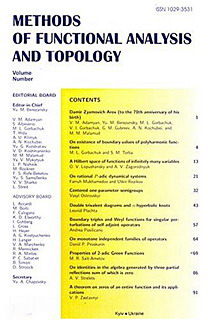Vol. 20 (2014), no. 4
Damir Zyamovich Arov (to 80th birthday anniversary)
MFAT 20 (2014), no. 4, 297-298
297-298
Vadym Movsesovich Adamyan (to 75th birthday anniversary)
MFAT 20 (2014), no. 4, 299-300
299-300
Darboux transformation of generalized Jacobi matrices
MFAT 20 (2014), no. 4, 301-320
301-320
Let $\mathfrak{J}$ be a monic generalized Jacobi matrix, i.e. a three-diagonal block matrix of special form, introduced by M.~Derevyagin and V.~Derkach in 2004. We find conditions for a monic generalized Jacobi matrix $\mathfrak{J}$ to admit a factorization $\mathfrak{J}=\mathfrak{LU}$ with $\mathfrak{L}$ and $\mathfrak{U}$ being lower and upper triangular two-diagonal block matrices of special form. In this case the Darboux transformation of $\mathfrak{J}$ defined by $\mathfrak{J}^{(p)}=\mathfrak{UL}$ is shown to be also a monic generalized Jacobi matrix. Analogues of Christoffel formulas for polynomials of the first and the second kind, corresponding to the Darboux transformation $\mathfrak{J}^{(p)}$ are found.
Spectral gaps of the Hill-Schrödinger operators with distributional potentials
Vladimir Mikhailets, Volodymyr Molyboga
MFAT 20 (2014), no. 4, 321-327
321-327
The paper studies the Hill-Schrödinger operators with potentials in the space $H^\omega \subset H^{-1}\left(\mathbb{T}, \mathbb{R}\right)$. The main results completely describe the sequences that arise as lengths of spectral gaps of these operators. The space $H^\omega$ coincides with the H\"{o}rmander space $H^{\omega}_2\left(\mathbb{T}, \mathbb{R}\right)$ with the weight function $\omega(\sqrt{1+\xi^{2}})$ if $\omega$ belongs to Avakumovich's class $\mathrm{OR}$. In particular, if the functions $\omega$ are power, then these spaces coincide with the Sobolev spaces. The functions $\omega$ may be nonmonotonic.
On generalized rezolvents and characteristic matrices of first-order symmetric systems
MFAT 20 (2014), no. 4, 328-348
328-348
We study general (not necessarily Hamiltonian) first-ordersymmetric system $J y'-B(t)y=\Delta(t) f(t)$ on an interval $\mathcal I=[a,b)$ with the regular endpoint $a$ and singular endpoint $b$. It isassumed that the deficiency indices $n_\pm(T_{\min})$ of thecorresponding minimal relation $T_{\min}$ in $L_\Delta^2(\mathcal I)$ satisfy$n_-(T_{\min})\leq n_+(T_{\min})$. We describe all generalized resolvents$y=R(\lambda)f, \; f\in L_\Delta^2(\mathcal I),$ of $T_{\min}$ in terms of boundary problemswith $\lambda$-depending boundary conditions imposed on regular andsingular boundary values of a function $y$ at the endpoints $a$and $b$ respectively. We also parametrize all characteristicmatrices $\Omega(\lambda)$ of the system immediately in terms of boundaryconditions. Such a parametrization is given both by the blockrepresentation of $\Omega(\lambda)$ and by the formula similar to thewell-known Krein formula for resolvents. These results develop the Straus' results on generalized resolvents and characteristicmatrices of differential operators.
On the accelerants of non-self-adjoint Dirac operators
MFAT 20 (2014), no. 4, 349-364
349-364
We prove that there is a homeomorphism between the space of accelerants and the space of potentials of non-self-adjoint Dirac operators on a finite interval.
Factorization formulas for some classes of generalized $J$-inner matrix valued functions
MFAT 20 (2014), no. 4, 365-378
365-378
The class $\mathcal{U}_\kappa(j_{pq})$ of generalized $j_{pq}$-inner matrix valued functions (mvf's) %and its subclass $\mathcal{U}^r_\kappa(j_{pq})$ was introduced in [2]. For a mvf $W$ from a subclass $\mathcal{U}^r_\kappa(j_{pq})$ of $\mathcal{U}_\kappa(j_{pq})$ the notion of the right associated pair was introduced in [13] and some factorization formulas were found. In the present paper we introduce a dual subclass $\mathcal{U}^\ell_\kappa(j_{pq})$ and for every mvf $W\in \mathcal{U}^\ell_\kappa(j_{pq})$ a left associated pair $\{\beta_1,\beta_2\}$ is defined and factorization formulas for $W$ in terms of $\beta_1,\beta_2$ are found. The notion of a singular generalized $j_{pq}$-inner mvf $W$ is introduced and a characterization of singularity of $W$ is given in terms of associated pair.
Existence theorems of the ω-limit states for conflict dynamical systems
MFAT 20 (2014), no. 4, 379-390
379-390
We introduce a notion of the conflict dynamical system in terms of probability measures, study the behavior of trajectories of such systems, and prove the existence theorems of the ω-limit states.
Spectral analysis of metric graphs with infinite rays
MFAT 20 (2014), no. 4, 391-396
391-396
We conduct a detailed analysis for finite metric graphs that have a semi-infinite chain (a ray) attached to each vertex. We show that the adjacency matrix of such a graph gives rise to a selfadjoint operator that is unitary equivalent to a direct sum of a finite number of simplest Jacobi matrices. This permitted to describe spectrums of such operators and to explicitly construct an eigenvector decomposition.


